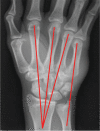Sensitivity and Specificity of Radiographs in the Diagnosis of Little and/or Ring Carpometacarpal Joint Injuries
- PMID: 33867767
- PMCID: PMC8041501
- DOI: 10.1055/s-0040-1709213
Sensitivity and Specificity of Radiographs in the Diagnosis of Little and/or Ring Carpometacarpal Joint Injuries
Abstract
Introduction Little and ring finger carpometacarpal joints (CMCJs) injuries are commonly missed due to misinterpretation of radiographs. We aimed to determine the sensitivity and specificity of four different radiographic views. Materials and Methods Radiographs (posteroanterior [PA], lateral [LAT], pronated oblique [POL], and supinated oblique [SOL] views) showing normal findings or little/ring finger CMCJ injuries were shown to two cohorts of orthopaedic trainees and a cohort of emergency nurse practitioners. Results The POL view performed best in all three testing scenarios. The SOL view performed least well. The combination of a PA, true LAT, and POL identified 78% of injuries correctly. In no cases did the SOL view correctly identify an injury when the other three views had been interpreted as normal. Conclusion We recommend a combination of the PA, POL, and LAT views in diagnosing these injuries. Where doubt remains, cross-sectional imaging is essential.
Keywords: carpometacarpal; dislocation; fracture; hamate; metacarpal.
Society of Indian Hand & Microsurgeons. All rights reserved. Thieme Medical and Scientific Publishers Pvt. Ltd., A-12, 2nd Floor, Sector 2, Noida-201301 UP, India.
Conflict of interest statement
Conflict of Interest None declared.
Figures



Similar articles
-
Retrospective interobserver agreement on diagnoses of 4th and 5th carpometacarpal fracture-dislocation and hamate fracture in plain X-ray - Is CT essential after ulnar carpometacarpal pain?Skeletal Radiol. 2023 Dec;52(12):2427-2433. doi: 10.1007/s00256-023-04366-9. Epub 2023 May 25. Skeletal Radiol. 2023. PMID: 37227483
-
Fracture dislocation of carpometacarpal joints: a missed injury.Orthopedics. 2011 May 18;34(5):399. doi: 10.3928/01477447-20110317-29. Orthopedics. 2011. PMID: 21598884
-
Carpometacarpal Dislocation with Third Metacarpal Fracture.Clin Pract Cases Emerg Med. 2021 Nov;5(4):488-490. doi: 10.5811/cpcem.2021.9.53202. Clin Pract Cases Emerg Med. 2021. PMID: 34813454 Free PMC article.
-
Management of fracture-dislocations of the little finger carpometacarpal joint: a systematic review.J Hand Surg Eur Vol. 2018 Jun;43(5):530-538. doi: 10.1177/1753193417752317. Epub 2018 Feb 7. J Hand Surg Eur Vol. 2018. PMID: 29411672
-
[Coronal fracture dislocation of the hamate and the base of the fourth metacarpal bone: a rare form of carpometacarpal injury].Handchir Mikrochir Plast Chir. 2011 Jun;43(3):140-6. doi: 10.1055/s-0031-1271802. Epub 2011 Apr 6. Handchir Mikrochir Plast Chir. 2011. PMID: 21472667 Review. German.
Cited by
-
Do Computerized Tomography Scans Change Management in Carpometacarpal Dislocations and Fracture-Dislocations?Hand (N Y). 2025 Jan;20(1):27-31. doi: 10.1177/15589447231200604. Epub 2023 Oct 4. Hand (N Y). 2025. PMID: 37791745 Free PMC article.
-
Radiographic views for hand fractures - call for three-view national UK guidelines - a quality improvement study.Int J Surg. 2023 Jul 1;109(7):1919-1922. doi: 10.1097/JS9.0000000000000381. Int J Surg. 2023. PMID: 37288596 Free PMC article.
References
-
- Hodgson P D, Shewring D J. The ‘metacarpal cascade lines’; use in the diagnosis of dislocations of the carpometacarpal joints. J Hand Surg Eur Vol. 2007;32(03):277–281. - PubMed
-
- Yoshida R, Shah M A, Patterson R M. Buford WL Jr, Knighten J, Viegas SF. Anatomy and pathomechanics of ring and small finger carpometacarpal joint injuries. J Hand Surg Am. 2003;28(06):1035–1043. - PubMed
-
- Chong A K, Chew W Y. An isolated ring finger metacarpal shaft fracture?–beware an associated little finger carpometacarpal joint dislocation. J Hand Surg [Br] 2004;29(06):629–631. - PubMed
-
- Pullen C, Richardson M, McCullough K, Jarvis R. Injuries to the ulnar carpometacarpal region: are they being underdiagnosed? Aust N Z J Surg. 1995;65(04):257–261. - PubMed
-
- Petrie P W, Lamb D W. Fracture-subluxation of base of fifth metacarpal. Hand. 1974;6(01):82–86. - PubMed
LinkOut - more resources
Full Text Sources
Research Materials

